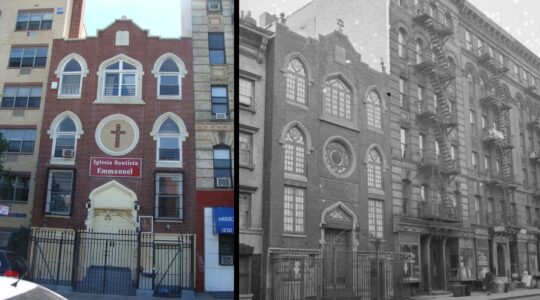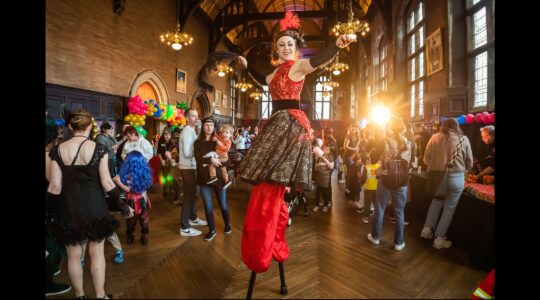The Yiddish writer known as S. Ansky, author of “The Dybbuk,” a play about haunted souls and the restless dead, said shortly after the infamous 1903 Kishinev pogrom, “Kishinev was Tisha b’Av,” that mid-summer mourning embracing every haunted, restless, epochal tragedy in Jewish history. Ansky could find no other date so fierce or frightening befitting Kishinev’s disaster.
Pogroms are associated with shtetls, but Kishinev was never that. At the dawn of the 20th century, Kishinev was urban, the fifth largest city in Russia; more Jews (50,000) than Frankfurt and Prague combined. Then on Easter week, 1903, a three-day pogrom left 49 Jews murdered; hundreds hospitalized; an estimated 600 raped; and thousands homeless.
The word “pogrom” — Russian for “thunder” or “storm” — was almost unknown prior to Kishinev. In his new book, “Pogrom: Kishinev and the Tilt of History” (Liveright), author Steven J. Zipperstein points out that a 1892 book on Russian Jews never even used the word pogrom. It was only after Kishinev, writes Zipperstein, a professor of Jewish culture and history at Stanford University, that the word “pogrom” emerged to denote the most merciless, violent attacks against Jews, short of the Nazis but a prelude.
As New York Times reporter Peter Steinfels wrote in 1998, “Before Kristallnacht there was Kishinev.”
Kishinev, and “pogrom,” have never left us. The persistent comparisons, writes Zipperstein, even if inexact, reflect the impact “that the Kishinev pogrom has had on the Jewish imagination.” No word but “pogrom,” writes Zipperstein, better articulates “Jewish vulnerability, the deep well of Jewish misery. And in stark contrast to the Holocaust, pogroms [are] never — despite their Russian origins — tethered to a particular time, place or dictator.”
Around the world, multi-day attacks on whole Jewish communities in Hebron (1929), Baghdad (1941) and Crown Heights (1991) were each called pogroms.
In 2004, in “The Plot Against America,” Philip Roth’s novel about anti-Semitism, he writes about a “sense of being undefended that had more to do with Kishinev and the pogroms of 1903 than with New Jersey 37 years later.”
In 2014, after a gruesome terror attack in Israel, Prime Minister Benjamin Netanyahu quoted Chaim Nachman Bialik’s poem about the Kishinev pogrom.
That same year, two Palestinians entered a synagogue in Jerusalem’s Har Nof with axes, knives and guns, killing five. The Economist compared the blood-drenched floor, books and clothes to “the age of pogroms.”
In 1903, Kishinev’s economy was elegant, evoking the good life, with wine vineyards, tobacco fields for expensive cigarettes smoked in New York, and plum orchards. The New York Times reported at the time, “It is doubtful if any town in Russia, the nation of fairs, has more of them than Kishinev,” bringing in “$1.5 million” (in 1903 dollars) annually. The Times headline: “Far From A Bad Place To Live, Except For A Jew.”
Kishinev’s only daily newspaper, edited by Pavel Krushevan, ran articles accusing Jews of killing a Christian boy to make matzah from his blood. (After the pogrom, notes Zipperstein, Krushevan went on to create “The Protocols of the Elders of Zion,” a forgery that became the quintessential anti-Zionist text.)
With tensions rising, Kishinev’s 72 synagogues were advising Jews to go directly home after Passover davening because of Easter, a day as haunted as Halloween for European Jews. However, some people lingered outdoors after church and shul. There was some pushing, shoving and taunting of Jews. Christian boys threw stones at Jewish buildings.
By early afternoon on that April 6, writes Zipperstein, seminarians began riling up the thickening crowd. First to be harassed were Jewish liquor stores, then Jewish tobacco shops. With twilight came calls to “Kill the Jews!”
“Pogromshiks,” as they were called, began storming down the streets, breaking windows. Christians with wagons hauled away the plunder. Jews distributed iron bars and wooden clubs for self-defense. Nothing worked quite like a gun. When pogromists tried to invade Yosef Aaron’s home, the Aaron brothers stood outside, shooting bullets in the air. The pogromists went elsewhere.
In one apartment, a Jewish woman was serially raped for four hours. In another home invasion, a broken wooden table was smashed on Jewish heads until the Jews died. In the street, one Jew called the name of a pogromist he knew; the pogromist killed him with a pitchfork.
The Jewish Historical Commission in Odessa commissioned Bialik, later Israel’s poet laureate, to interview pogrom survivors. Bialik then wrote his poem, “In the City of Slaughter,” about the “crouched husbands, bridegrooms, brothers, peering from the cracks,” as wives and daughters were raped.
Rivka Schiff, 24, a married woman, told Bialik: “Mitya Kresilchik sought to abuse me. … I pleaded for mercy. ‘Don’t touch me, Mitya. You have known me for many years. … Others ripped open the back of my dress; one slapped me and said: ‘If you have no money, we will get pleasure from you in another way.’ I fell to the ground with Mitya on top of me, and he started to have his way with me. The other gang members surrounded me and waited … mocking and abusing. … I don’t know how many had their way with me, but there were at least five, and possibly seven. … I was pulverized, and crushed like a vessel filled with shame and filth.”
Another woman testified that she knew her rapist from the time he was a baby, when she held him in her arms.
The sons of a local shoemaker — who hid behind a stove while their father was beaten and murdered — recognized the killer as a neighbor whose shoes they repaired. Pogromists grabbed another Jew “and plucked out his tongue while he was alive.”
After calm returned, survivors told The Times, Jews began “gradually making their way [back] from the outlying forests where they fled like hunted animals.”
Bialik thought the Jews were passive but at the post-pogrom trials (several hundred pogromists were arrested), a defense attorney argued that the disturbances would have quickly ended had the Jews not been so violent in their over-reaction to the fighting.
Zipperstein, 67, told us by phone, “What I came to appreciate was the astonishing power of fiction, of myth over history.” One myth was Jewish passivity and cowardice, “when, in fact, there was a considerable amount of resistance. But Bialik was telling a truth, an uncomfortable truth, even if it wasn’t the entire truth. Poetry is about myth. It’s not the entire story but poetry doesn’t set out to tell the entire story.”
What I came to appreciate was the astonishing power of fiction, of myth over history.
Zipperstein added, “I was always interested in the outsized influence of the Kishinev pogrom, not just on Jews but on non-Jews, even anti-Semites,” as Kishinev was the hometown, after all, of the Protocols of the Elders of Zion. Zipperstein believes that Jacob Bernstein-Kogan (a delegate to the First Zionist Congress in 1897) was almost certainly Krushevan’s model for the “Elder.” Bernstein-Kogan was a good-hearted man, not rich, but “he ends up being the Protocol’s image for the most powerful Jew in the world.”
Bernstein-Kogan was hardly powerful but he was a leader. With the onset of pre-pogrom incitement, he invited Jews to stockpile weapons in his apartment. And Bernstein-Kogan, as a Zionist “correspondence officer,” had one of the few telephones, with contact information for important newspapers. Through him, news of the pogrom was quickly disseminated across Europe, and pogrom photographs greatly appealed to the Hearst newspapers, as well.
Had the Jews not left, Kishinev would be far better off economically.
Zipperstein is convinced that the speed of both the news and relief efforts “had to do with Kishinev’s location,” near the Austrian-Hungarian and Romanian borders, “the most porous of all corners of the Russian empire … and that’s probably why the Zionists established the bureau in Kishinev.”
It’s a reminder, Zipperstein told us, “of the element of chance that makes for history. I’m convinced that if the same event occurred 200 miles to the east” it would have been a lost story. If the pogrom happened in an inland city without a Jewish publicity expert; if, on what became the second day of the pogrom, the morning rain didn’t stop but was an all-day rain, emptying the streets, the pogrom might have been abridged into obscurity. But the rain stopped.
Today, there are two shuls in Kishinev where “Eicha,” the Book of Lamentations, will be read this weekend on Tisha b’Av: “How the city sits solitary that was once full of people.” After a rough century, a city of 50,000 Jews is now 3,500, an ember. Zipperstein spoke to one Christian woman there who told him, “The real reason for the outbreak of the 1903 pogrom was that the city was packed with far too many Jews, justly exasperating locals.” Now, equally exasperating, Kishinev’s problem is too few Jews: “Had the Jews not left, Kishinev would be far better off economically.”
It’s always something.
The New York Jewish Week brings you the stories behind the headlines, keeping you connected to Jewish life in New York. Help sustain the reporting you trust by donating today.




